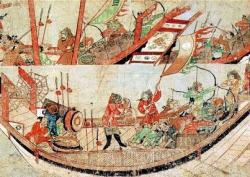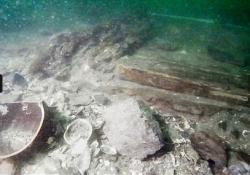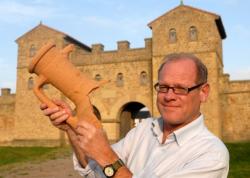25 OCTOBRE
INDI-UNI : ANTHROPOLOGY - ARCHAEOLOGY
INSCRIPTION 2011 – 2012 COURS A DISTANCE
REGISTRATION 2011 – 2012 ONLINE COURSES
JAPON – 
 Takashima Island - The wreck of a Mongolian ship presumed to have been part of a 13th century invasion fleet has been discovered beneath the seabed off southern Japan. Researchers have previously only been able to recover anchor stones and cannonballs from the scattered wrecks of the Mongol fleets and they believe that this latest find will shed new light on the maritime technology of the day. The warship was located with ultrasonic equipment about 3 feet beneath the seabed at a depth of 75 feet. The archeological team, from Okinawa's University of the Ryukus, had been carrying out a search of the waters around Takashima Island, in Nagasaki Prefecture, because the area had yielded other items from Mongol ships. Historical records suggest that some 4,400 ships carrying 140,000 Mongol soldiers landed in Japan in 1281 and skirmished with samurai in northern Kyushu. But after returning to their boats, the fleet was struck by a devastating typhoon that put an end to the invasion plans - a storm known to all Japanese as "kamizake," meaning divine wind. A section of the ship's hull was first found last year but a full archeological excavation only began on September 30. The researchers uncovered a keel nearly 50 feet long and more than 1.5 feet wide. Lengths of wood planking were still buried beneath silt alongside the main spars, they said. The planks were as much as 9 inches wide and nearly 4 inches thick and were still coated in a grey paint. The planks had been held in place by nails and more than 300 bricks that were used as ballast were located throughout the site, along with ink stones and shards of Chinese ceramics. The archeologists have also recovered weapons and identified the remains of the ship's ribs and bulkheads. The mast and upper structures have been lost, the researchers said, but historians are marvelling at the discovery of the first near-complete pre-medieval wooden ship in Japan.
Takashima Island - The wreck of a Mongolian ship presumed to have been part of a 13th century invasion fleet has been discovered beneath the seabed off southern Japan. Researchers have previously only been able to recover anchor stones and cannonballs from the scattered wrecks of the Mongol fleets and they believe that this latest find will shed new light on the maritime technology of the day. The warship was located with ultrasonic equipment about 3 feet beneath the seabed at a depth of 75 feet. The archeological team, from Okinawa's University of the Ryukus, had been carrying out a search of the waters around Takashima Island, in Nagasaki Prefecture, because the area had yielded other items from Mongol ships. Historical records suggest that some 4,400 ships carrying 140,000 Mongol soldiers landed in Japan in 1281 and skirmished with samurai in northern Kyushu. But after returning to their boats, the fleet was struck by a devastating typhoon that put an end to the invasion plans - a storm known to all Japanese as "kamizake," meaning divine wind. A section of the ship's hull was first found last year but a full archeological excavation only began on September 30. The researchers uncovered a keel nearly 50 feet long and more than 1.5 feet wide. Lengths of wood planking were still buried beneath silt alongside the main spars, they said. The planks were as much as 9 inches wide and nearly 4 inches thick and were still coated in a grey paint. The planks had been held in place by nails and more than 300 bricks that were used as ballast were located throughout the site, along with ink stones and shards of Chinese ceramics. The archeologists have also recovered weapons and identified the remains of the ship's ribs and bulkheads. The mast and upper structures have been lost, the researchers said, but historians are marvelling at the discovery of the first near-complete pre-medieval wooden ship in Japan.
http://www.telegraph.co.uk/news/worldnews/asia/japan/8848282/13th-century-Mongolian-wreckage-discovered-off-Japanese-seabed.html
GRECE – Zakros - Minoan civilisation, and Zakros Palace in particular, are the focus of the 11th International Cretological Congress on October 21-27 in Rethymnon, one of the three big cities on the island. The Minoan Zakros Palace, located on the eastern part of the island, is one of the four Minoan palaces - the others are Knossos, Festos and Malia - uncovered by archaeological excavations last century. The palace spans 4,500 square metres (one fifth of the area of the Palace of Knossos) and was the religious and administrative centre for a settlement that spanned 8,000 square metres. The palace has two main structures, built over 2 different periods. The first was constructed around 1900 BC (during the same period as the Palace of Knossos) and the more recent construction is from around the year 1600 BC. The palace was destroyed, along with the other settlements on the island, in 1450 BC by a catastrophic earthquake almost certainly followed by a tsunami and was not rebuilt. The first archaeological excavations in Zakros, which began in the year 1900 and were carried out by the English Archaeological School, uncovered about 10 houses from the Late Minoan period and many interesting ceramic fragments, copper items from the prehistoric period and others, considered to be among the most important discoveries on Minoan civilisation. During WWII excavations stopped and were not resumed until 1961 by Greek archaeologist Nikolaos Platon, and they are still continuing today. During the Congress in Rethymnon, Lefteris Platon, Nikolaos' son, will present studies carried out on the ruins which show how the construction of Zakros Palace, after the natural disaster in 1450 that destroyed all Minoan-era buildings in Crete, marks a radical change in the political and economic character of the site. "Recent restoration work and studies on the archaeological material from Zakros Palace," said Lefteris Platon, "come in addition to several new and particularly interesting finds that we think are related to a goal to transport the political and ideological concept of Knossos in the heart of the local Minoan community." "The construction of this palace," continued the archaeologist, "was an integral part of a large project to extend the influence of Knossos during that period to several strategic points of Minoan sovereignty. Several of the symbols that appear at different Minoan sites in the area were created at Knossos and were used as propaganda for its political and ideological domination in the development of the Minoan world."
http://ansamed.ansa.it/en/cultura/news/ME.XEF05673.html
ROYAUME UNI -  Arbeia Roman Fort - THE “spectacular” discovery of ancient pottery has revealed how the Romans wined and dined here in South Tyneside almost 2,000 years ago. And far from sampling the delights of our local brews, it seems they still preferred to ship wines from the Mediterranean to their northern outpost. Several pieces of a 3ft-tall wine jug have been found during an excavation just outside Arbeia Roman Fort. The pottery will be stuck together to recreate the metre-high jug, which would have contained numerous litres of wine when it was imported to the fort between AD 250 and AD 350. The container is made of clay, and includes volcanic rock, and is believed to have been imported on a ship from Campania in Italy. The jug was found in a roadside gully during the excavations, on the corner of Baring Street and Fort Street, South Shields. Smaller pieces of other similar jugs were also found. A stone building was also discovered, which suggests there was still occupation and activity in the area in about AD 260, when most civilian settlements outside forts in the north of England had been abandoned.
Arbeia Roman Fort - THE “spectacular” discovery of ancient pottery has revealed how the Romans wined and dined here in South Tyneside almost 2,000 years ago. And far from sampling the delights of our local brews, it seems they still preferred to ship wines from the Mediterranean to their northern outpost. Several pieces of a 3ft-tall wine jug have been found during an excavation just outside Arbeia Roman Fort. The pottery will be stuck together to recreate the metre-high jug, which would have contained numerous litres of wine when it was imported to the fort between AD 250 and AD 350. The container is made of clay, and includes volcanic rock, and is believed to have been imported on a ship from Campania in Italy. The jug was found in a roadside gully during the excavations, on the corner of Baring Street and Fort Street, South Shields. Smaller pieces of other similar jugs were also found. A stone building was also discovered, which suggests there was still occupation and activity in the area in about AD 260, when most civilian settlements outside forts in the north of England had been abandoned.
http://www.shieldsgazette.com/lifestyle/entertainment/fort_find_adds_to_potted_history_of_romans_boozing_1_3904282
PANAMA – Portobelo - Treasure hunters claim they have discovered two ships from Sir Francis Drake’s fleet off the coast of Panama and believe his coffin could lie on the seabed nearby. His burial at sea in full armour and in a lead casket was designed to ensure that no one – but especially the Spanish – would find his body. Now, more than 400 years after Sir Francis Drake's death in the Caribbean, the great seafarer's watery grave may be close to being discovered. A team of treasure hunters led by an American former basketball team owner claims to have discovered two ships from Drake's fleet lying on the seabed off the coast of Panama. The 195-ton Elizabeth and 50-ton Delight were scuttled shortly after the naval hero's death from dysentery, aged about 55, in 1596. It is thought that Drake's final resting place may be nearby. Drake fell ill a few weeks after failing to conquer the port of Las Palmas. He died while anchored off the coast of Portobelo and his two badly damaged ships were scuttled to avoid them, or their contents, falling into Spanish hands. Mr Croce's team, which includes experts and explorers from Britain, France, Australia, Panama and Colombia, used what diving experts have described as the most sophisticated equipment in the world to scan the ocean floor. After locating the two ships, they now hope to find Drake's body, which has long been the target of treasure hunters and historians. Drake, one of the key figures of the Elizabethan court, is revered for his defeat of the Spanish Armada in 1588. One of Britain's greatest adventurers, he became only the second seafarer in history to circumnavigate the world between 1577 and 1580.
http://www.telegraph.co.uk/news/worldnews/centralamericaandthecaribbean/panama/8847105/Sir-Francis-Drakes-final-fleet-discovered-off-the-coast-of-Panama.html
INDE – Bapatla - The five centuries-old 'galigopuram' (tower) of the famous Sri Bhavannarayana Swamy temple at Bapatla in Guntur district collapsed on Sunday. This was second such historic structure in the state to crash down after the rajagopuram of Srikalahasti temple crumbled last year. The galigopuram stood at a 75-feet tower close to a five-storied building. When contacted, Archaeological Survey of India (ASI) superintendent R Krishnaiah expressed shock over the collapse of the structure.
http://articles.timesofindia.indiatimes.com/2011-10-24/hyderabad/30315872_1_endowments-temple-structure-srikalahasti